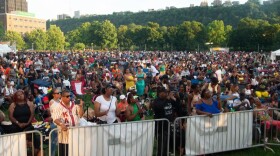This is WESA Arts, a weekly newsletter by Bill O'Driscoll providing in-depth reporting about the Pittsburgh area art scene. <i>Sign up here to get it every Wednesday afternoon</i>.
Looks like it’s time for our semi-monthly restatement of the question “Where have all those performing arts patrons gone?”
The news peg this week is Pittsburgh CLO’s launching of three new programs to win back old audiences, or win over new ones. For its six-show summer season, the venerable producer of homegrown musical theater will offer discounted tickets for children; free child care at Saturday matinees; and a trolley shuttle Downtown from suburban shopping centers.
The reasoning is that — especially in the wake of a pandemic shutdown from which audience numbers have never fully recovered — there are “barriers” to attendance. That is, people want to see classic shows like “Oklahoma” and newer ones like “The Color Purple,” but the cost of paying full price to bring kids is too high; the expense of hiring a babysitter is daunting; and driving and parking Downtown is aggravating and pricey.
At least, those are some of the things CLO executive producer Mark Fleischer said people told him informally, messages that were seconded by focus groups that included everyone from longtime CLO subscribers and recent single-ticket buyers to people who’d never even heard of the 78-year-old troupe.
Other local performing arts nonprofits have reached similar conclusions. In February, Pittsburgh Opera announced a novel plan to offer a limited number of free Uber rides to the rest of its Downtown productions this year.
That initiative debuted with the four March performances of “La Traviata” at the Benedum Center. Opera spokesperson Chris Cox said 21 ride-hailing vouchers were redeemed by patrons who purchased a total of 43 tickets.
That might not sound like a lot for a venue with 2,800 seats, but the Opera calls it a great start. Thirty of those tickets — about 70% — went to people who’d never attended a Pittsburgh Opera production before, Cox said. So the program — which after all, is brand new — did just what it was supposed to, if on a small scale.
That program, like the CLO’s initiatives, was funded by a package of grants from the Richard King Mellon Foundation to shore up Downtown arts groups — as well as Downtown itself.
Still, one can’t help but compare the struggle of traditional performing arts nonprofits — from small theater and dance troupes up to the Pittsburgh Symphony Orchestra — to the experience of the pop-concert industry.
Just like theaters, opera houses and symphony halls, concert venues that host touring pop acts completely shut down in 2020 and didn’t fully open again for more than a year. But while most performing arts groups say attendance is still down by 10% to 20% from pre-pandemic levels, the Associated Press reported last week that concert attendance set a record in 2023. About 145 million tickets were sold, up 20% from 2022 and up nearly 50% from 2019, the last full year before the pandemic.
You could partly write off the disparity to demographics. After all, the average age of fans filling stadiums for Taylor Swift and Beyoncé skews a few decades younger than the folks trooping to “Tosca” or “A Midsummer Night’s Dream.” Yet older acts from Elton John and the Rolling Stones to Bruce Springsteen and the E Street Band have also drawn their older fans quite well post-pandemic.
So what’s the difference? Why will folks still shell out to see their favorite singers — often at hundreds of dollars a pop — while many fans of theater, classical music and even musical theater are still staying away?
Some arts-goers just got out of the habit, of course, perhaps some of them permanently. But by this point, we know there’s no one answer.
When I asked the CLO’s Fleischer, he said that coming off the shutdown, people wanted not just any old experiences, but “visceral” ones.
“I think that’s why you’re seeing concerts and festivals [draw well], and I think that’s also why you see arts groups try to figure out, ‘Where’s the visceral, not just sit-down [element]?’” he said.
The Pittsburgh Symphony is among the groups that’s been presenting music in new formats, and supplementing its traditional concerts with lobby activities. The CLO is doing that too, with live music in the lobby before shows and more.
“I say to my staff, ‘We have to be more than turning the lights off on people for two hours,’” said Fleischer. “What’s that experience?”





